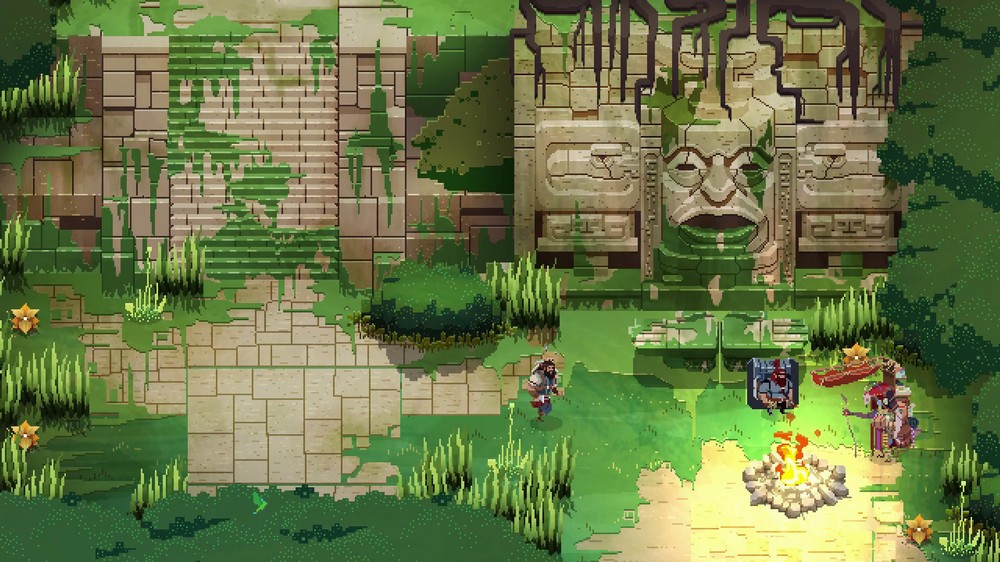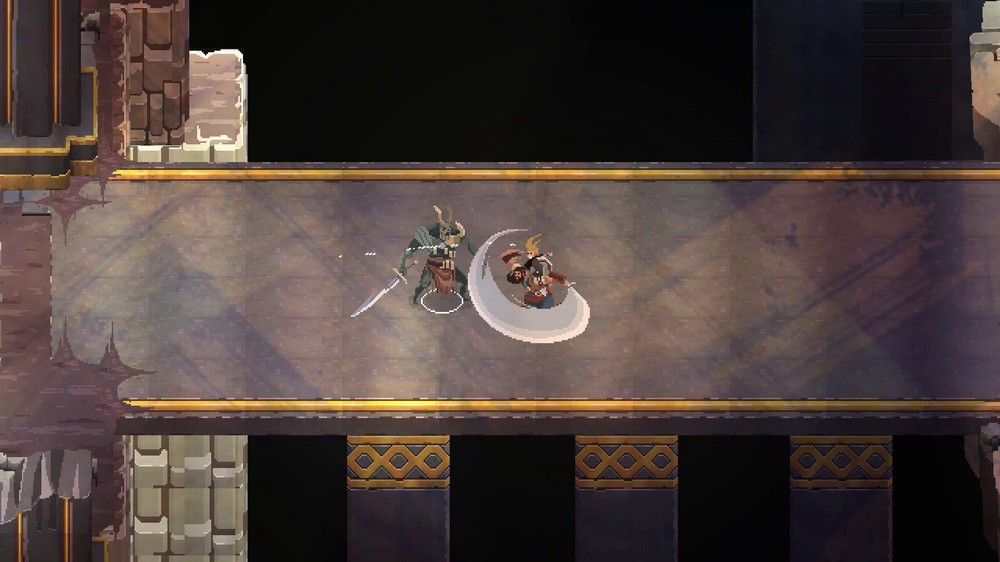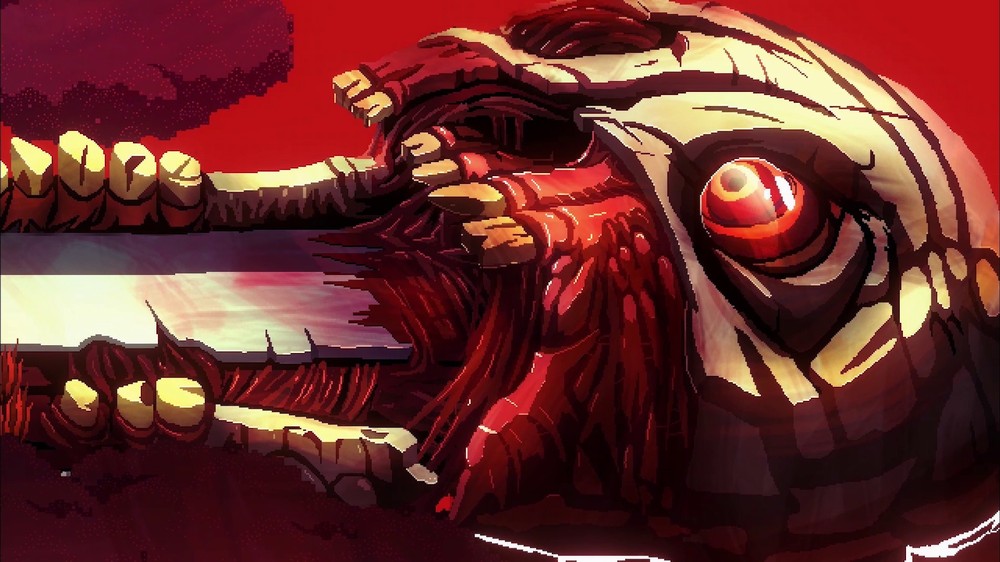The games industry is in a constant state of chasing best sellers and hot trends. In the aughts and the early 10s publishers and developers nipped at the heels of Call of Duty’s tight gunplay and addictive multiplayer. Here we are in the early 20s and the pendulum has roared away from prestige shooters and toward Souls-like adventures filled with lore and challenge. No Place for Bravery, a 2D top-down action RPG, wears its influences like a badge of honor, but it’s not just an imitation. It’s not perfect, but its themes and interesting narrative choices take Glitch Factory’s action-adventure game from just another Souls-like to something with a little more heart.
No Place for Bravery is a classic revenge tale. You play as Thorn, a grizzled ex-warrior fighting to reclaim his daughter from an evil warlock, who kidnapped her ten years prior to the start of the game. Thorn is joined in his quest by his disabled foster son, Phid, who he carries on his back. Along the way, Thorn slays through countless enemies and executes them in the bloodiest of fashions. No Place for Bravery is about the lengths one goes for family and the cost of revenge. I couldn’t help but think of The Last of Us Part II as I swung my warhammer down on a 2D enemy skull. Both games ask, “When is enough, enough?” While Naughty Dog leaves that question open-ended amongst all the violence, Glitch Factory gives players the opportunity to step away and decide their own path for Thorn. With TLOU2, I found myself disconnecting and questioning Ellie’s warpath through that game. I don’t want to dive too deep into spoilers but having the choice to say ‘no’ and end the violence just feels refreshing. With Thorn, his path was up to me, and the consequences of my actions were mine and mine alone.
 Between the Nordic myth inspired characters and visuals, and the father-son pairing, it’s easy to draw parallels to 2018’s God of War. It’s a fair comparison, but the relationship between Thorn and Phid started to give me Lee and Clementine vibes (Telltale’s Walking Dead) more than anything. Phid is present for all the violence. Throughout the game, Thorn is given choices to make, with some tilting toward the immoral side. Phid comments on how situations are handled, and while it doesn’t affect the overall story it does lead to some interesting character moments between the two.
Between the Nordic myth inspired characters and visuals, and the father-son pairing, it’s easy to draw parallels to 2018’s God of War. It’s a fair comparison, but the relationship between Thorn and Phid started to give me Lee and Clementine vibes (Telltale’s Walking Dead) more than anything. Phid is present for all the violence. Throughout the game, Thorn is given choices to make, with some tilting toward the immoral side. Phid comments on how situations are handled, and while it doesn’t affect the overall story it does lead to some interesting character moments between the two.
Aside from all the comparisons, No Place for Bravery is fun to play. It’s challenging but not unforgiving. Most deaths were a result of my hardheadedness and desire to try and rush through a room, and less about what the game threw at me. Combat falls back on managing energy and dexterity. Timing your attacks and looking for a chance to parry an enemy leads to success, whereas tapping ‘X’ repeatedly will lead to multiple game overs. I did find myself struggling with the auto-aim. Thorn will lock onto an enemy with a click of the right thumbstick, which is signified by a small dot over the enemy. In bigger battles, where the camera is pulled out, it can be hard to tell who you’re locked onto.
 There’s a small weapon variety that adheres to different playstyles. For my preference, I love opening with ranged attacks with the crossbow and then switching over to the sword for any enemies that get too close. Even with only three main weapons to choose from, the exclusion of a weapon wheel here feels like a missed opportunity. A minor annoyance, but when every second counts, cycling through weapons to get to the one you want can be life-or -death. There’s also a section later in the game that strips you of everything but your crossbow. I personally didn’t mind it but could see how some players would be displeased with losing their sword and warhammer. You can also craft additional items for healing, aoe attacks, and adding effect damage to enemies. These can help change the tide of a battle and add even more variety to your play as you conquer each biome.
There’s a small weapon variety that adheres to different playstyles. For my preference, I love opening with ranged attacks with the crossbow and then switching over to the sword for any enemies that get too close. Even with only three main weapons to choose from, the exclusion of a weapon wheel here feels like a missed opportunity. A minor annoyance, but when every second counts, cycling through weapons to get to the one you want can be life-or -death. There’s also a section later in the game that strips you of everything but your crossbow. I personally didn’t mind it but could see how some players would be displeased with losing their sword and warhammer. You can also craft additional items for healing, aoe attacks, and adding effect damage to enemies. These can help change the tide of a battle and add even more variety to your play as you conquer each biome.
The usual trappings of a Souls-like are all present. You rest and save your progress at a shrine. There are multiple biomes with vastly differing characteristics and fascinating lore told through pages and items you find in the world. The gloomy yet colorful 2D world of No Place for Bravery looks great. My only gripe with the art direction are the times the camera pulls in for cutscenes or executions. Close-up, the character models get blurry and do not look the greatest. Aside from that, the surrounding world is beautiful. From Ossuary, the village built on the remains of a giant, to the Tooth, a sorcerer’s hideout surrounded by a dank swamp, built into a literal dragon’s tooth, each biome feels unique and lived in. Approaching one dungeon, I found myself hunted by invisible enemies. The only tell of their presence was the dust they kicked up or tall grass bustling. A feeling of dread entered me, before I remembered I was Thorn, a feared warrior on the battlefield. The lore of the game explores a major war that Thorn and his companions played a part in. You don’t need the backstory to appreciate what’s going on in the present, but it does paint an interesting picture of Thorn, his allies, and his adversaries.
 Along with the combat comes some light platforming. Dashing from platform to platform, flipping switches, opening new areas with new weapons, it’s all been done before and doesn’t take away from the core of the experience. The difficulty increases with each new biome. For example, a later enemy, the sorcerers, cover all of the opposition in a magical shield. With just your sword, this requires the player to take down any sorcerer in the area before they are able to take down other enemies. Upon receiving the warhammer, this becomes a less tedious encounter type, with the hammer able to blow through any shield. If you do find things are getting too tough, the game does have a ‘Story’ difficulty, that allows players to get the jump on enemies, so they can proceed through the story beats.
Along with the combat comes some light platforming. Dashing from platform to platform, flipping switches, opening new areas with new weapons, it’s all been done before and doesn’t take away from the core of the experience. The difficulty increases with each new biome. For example, a later enemy, the sorcerers, cover all of the opposition in a magical shield. With just your sword, this requires the player to take down any sorcerer in the area before they are able to take down other enemies. Upon receiving the warhammer, this becomes a less tedious encounter type, with the hammer able to blow through any shield. If you do find things are getting too tough, the game does have a ‘Story’ difficulty, that allows players to get the jump on enemies, so they can proceed through the story beats.
If you’re breezing through the game and feel like your skills are going untested, the boss fights will bring you back down to Earth. The first boss sets the tone for the rest of the game. One wrong move and the game will punish you. For example, a later fight has a boss launching multiple magical projectiles at you. If you’re slow to react you’ll get hit, not just by one, but every projectile. Again, it’s not unforgiving, but does require you to react quickly or load up another attempt. I was concerned about boss variety after the first two fights played pretty similarly with a focus on melee, but those concerns were put to rest as I took on later bosses, one of which is a bullet hell monstrosity. There are also some interesting side enemies, not seen through the rest of the campaign. These add some additional variety and challenge for players going off the beaten path.
No Place for Bravery on the surface level is a Souls-like with a great looking coat of 2D paint. It’s also a game that begs you to look beyond the surface as it explores themes in letting go and giving the power of choice back to players. Glitch Factory has delivered a heartfelt adventure that looks great and is fun to play. The difficulty may chase some away, but fan of the genre or not, anyone with a few hours to kill will find something to love about it.













